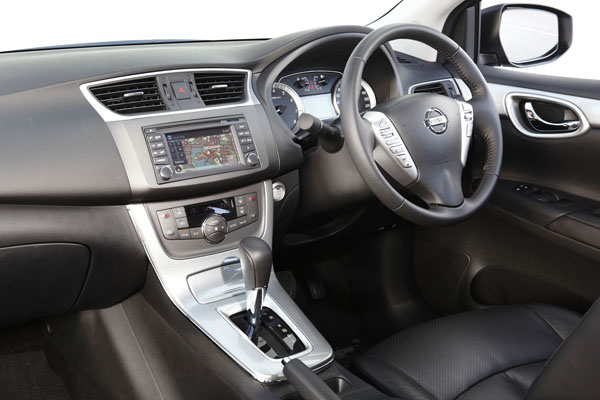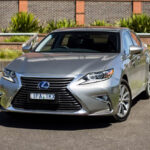The name ‘Pulsar’ is back in the Nissan fold, replacing the much-unloved ‘Tiida’ tag to the delight of just about everyone in any way connected with Nissan in Australia – be they owners, buyers or sellers.
The subject of this road test is a top-of-the-line 1.8-litre Pulsar Ti sedan. Four doors are the only body type on offer at this time. Pulsar hatch, including the sporty SSS, powered by a 1.6-litre turbocharged, direct injection engine is due downunder mid year.
The five new Pulsar sedans range from just $19,990 to the $28,990 Ti we drove, and there is plenty to choose from both in features and price.

The Pulsar has Nissan’s new style trapezoidal radiator grille and large wraparound headlights. Riding on 17-inch alloy wheels, the Pulsar Ti’s low stance and belt line add to its appearance of length.
The new Pulsar comes in three specification levels: ST, ST-L and Ti. They can be ordered with either a six-speed manual gearbox or Nissan’s new Xtronic CVT (continuously variable transmission) offering smoother acceleration and broader gear ratios than a conventional automatic. The Ti we tested comes only with the CVT.
Interior space is impressive. New Pulsar has a longer cabin than its main rivals, making for extensive rear-seat legroom than can carry two adults in comfort.
Pulsar has a co-efficient of drag of just 0.30, this is partly due to the attention paid to the vehicle’s underbody, with air flow funneled by a large front spoiler past the front and rear wheels via strategically-placed deflectors.

A stiff body structure is designed to maximise occupant protection and minimise vibration, while mechanical and road noise have been isolated by sound absorbing materials.
Soft-touch segments – dashboard and driver’s door armrest – plus leather seat accents imbue the cabin with a feeling of quality, while the Ti must have close to the most comfortable seats in class. Not nodding off comfy, but long-distance comfy.
Gauges, set out on an instrument panel that curves outwards to the doors, are backlit, even in daylight, making them easy to read.
The Pulsar Ti has all the advantages of hands-free Bluetooth and MP3/iPod connectivity, six-speaker audio, touch-screen colour display, reversing camera with guide lines and satellite navigation.
Pulsar’s 1.8-litre four-cylinder engine develops peak power of 96 kW and maximum torque of 174 Nm. It’s mated with a CVT, resulting in a quiet, continuous delivery of power. The CVT has what Nissan calls Smooth Start Assist control. This irons out any accelerator pressure imperfections, which makes the car accelerate in a smooth and fuel-efficient manner.
Smart Revolution Control keeps engine speed constant even if a driver operates the accelerator pedal roughly under gentle acceleration, while it also smoothes irregularities of vehicle speed on undulating roads. Without the driver noticing, it all adds up to minimising fuel consumption and enhancing drivability.
During extended open road cruising ‘our’ Nissan Pulsar Ti used five to six litres per 100 kilometres. In town it recorded nine to ten litres per hundred.
While most of the automotive world measures fuel consumption in litres per hundred kilometres, the Japanese do so in kilometres per litre, which is shown in Australian import’s dash displays of current Pulsars. Hopefully, Nissan Australia will have this corrected on future models.
Safety systems include front, side and curtain airbags; ABS brakes with electronic brake distribution and brake assist; traction control and vehicle dynamic control.
It’s still early days, but it’s already looking as though dumping the Tiida and reintroducing the Pulsar is paying big dividends in sales. It’s not just the name change that’s doing the work, our week in the Pulsar has impressed us with its competence in many fields.
AT A GLANCE
MODEL RANGE
ST 2.0-litre four-door sedan: $19,990 (manual), $22,240 (CVT automatic)
ST-L 2.0-litre four-door sedan: $23,650 (manual), $25,900 (CVT automatic)
Ti 2.0-litre four-door sedan: $28,990 (CVT automatic)
Note: These prices do not include government or dealer delivery charges. Contact your local Nissan dealer for drive-away prices.
SPECIFICATIONS (Nissan Pulsar Ti 2.0-litre four-door sedan)
ENGINE:
Capacity: 1798 cc
Configuration: four-cylinder in-line, DOHC, four valves per cylinder
Bore and stroke: 79.7 mm x 91 mm
Compression ratio: 9.9:1
Maximum Power: 96 kW @ 6000 rpm
Maximum Torque: 174 Nm @ 4800 rpm
DRIVELINE:
Driven wheels: Front
Transmission: Xtronic continuously variable transmission
DIMENSIONS, WEIGHT AND CAPACITIES:
Length: 4615 mm
Width (excluding mirrors): 1760 mm
Height: 1495 mm
Wheelbase: 2700 mm
Track: 1530 mm (front / rear)
Minimum ground clearance: 160 mm
Turning circle: 10.7 m
Tare mass: 1258 kg (CVT)
Gross vehicle mass: 1740 kg
Towing capacity: 1100 kg (braked); 750 kg (unbraked)
Fuel tank capacity: 52 litres
SUSPENSION AND BRAKES:
Front Suspension: Independent MacPherson struts with stabiliser bar
Rear Suspension: Torsion beam with stabiliser bar
Brakes: ABS anti-skid with Brake Assist, Electronic Brake force Distribution, Traction Control, Vehicle Dynamic Control
Steering: Rrack-and-pinion speed sensitive electric power steering
Wheels / tyres: 17in / 6.5J alloy / 205/50 R17 (Full-size steel spare wheel)
PERFORMANCE:
Acceleration 0-100 km/h: N/A
Maximum speed: N/A
FUEL CONSUMPTION:
Recommended fuel: Unleaded 91 RON
Combined Cycle (ADR 81/01): ST 6.7 L/100 km
CO2 emissions 160 g/km
GREEN VEHICLE GUIDE RATINGS:
Greenhouse Rating: 7.5/10 Air Pollution Rating: 6.5/10
STANDARD WARRANTY
Three years/100,000km












